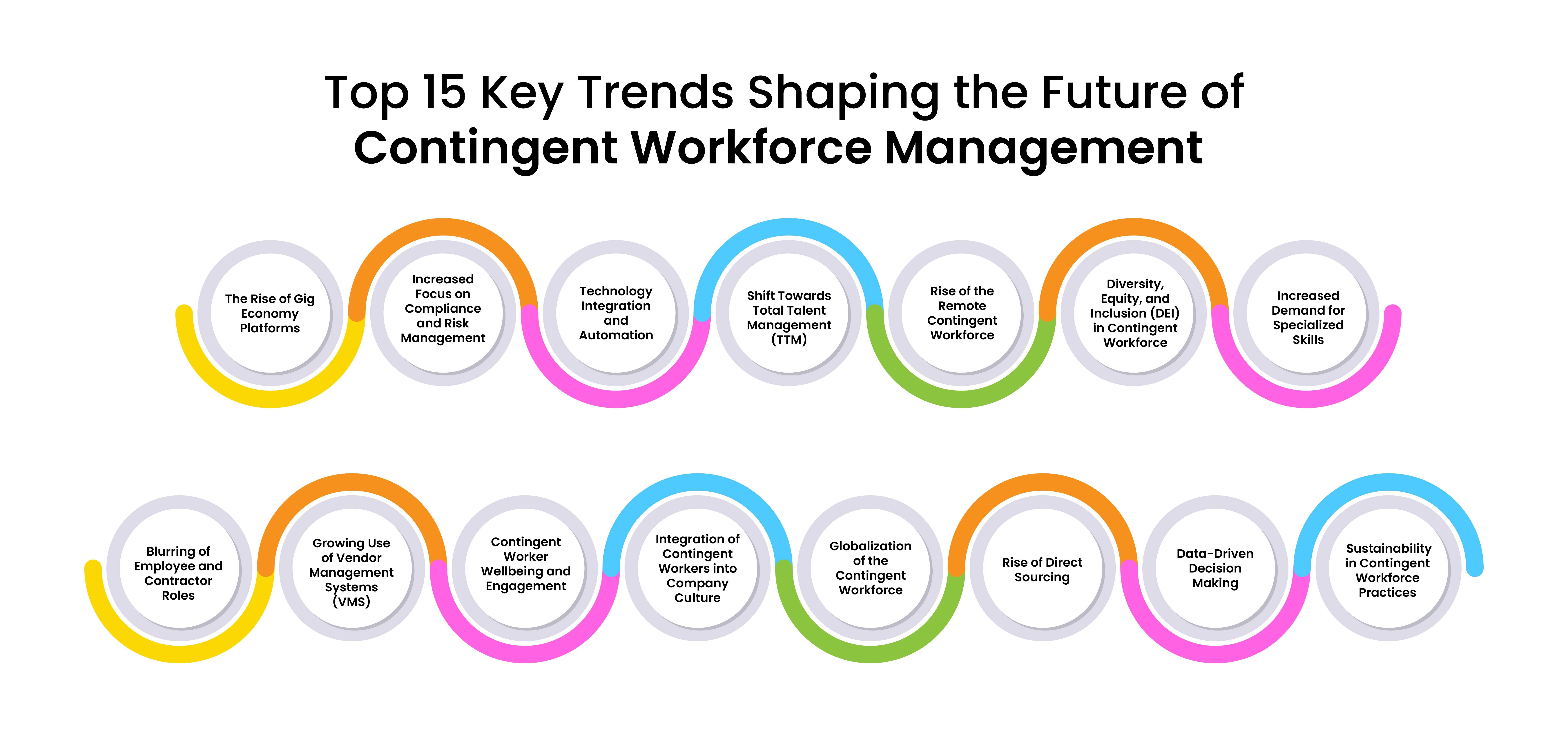Top 15 Key Trends Shaping the Future of Contingent Workforce Management

The extended workforce is growing at a remarkable pace. A late 2022 report placed the broad non-employee workforce (gig economy) at 36% of the workforce in the U.S., highlighting the increasing reliance on flexible labor. Another study projects that the contingent workforce will expand by 34% in 2024 and another 25% in 2025. In the UK, while permanent hiring has slowed in early 2024, non-employee staffing remains steady, indicating the continued importance of flexible workers in modern labor markets.
These shifts in employment trends are reshaping how businesses manage their workforce. From the rise of gig economy platforms to the integration of AI and data analytics, companies are navigating an evolving landscape that prioritizes flexibility and efficiency. Below, we explore the top 15 key trends shaping the future of contingent workforce management and how organizations can leverage these trends to optimize their workforce strategies.

1. The Rise of Gig Economy Platforms
The gig economy is no longer a niche market. With platforms like Upwork, Freelancer, and Fiverr growing exponentially, organizations are increasingly turning to these platforms to access contingent talent on demand. According to a report by Mastercard, the global gig economy is projected to grow to $455 billion by 2023, reflecting the growing preference for flexible, project-based work.
How to Utilize This Trend:
- Leverage gig economy platforms to quickly access specialized talent for short-term projects.
- Diversify your talent sources by integrating multiple platforms to cover different skill sets and regions.
- Build relationships with high-performing freelancers to create a reliable talent pool.
2. Increased Focus on Compliance and Risk Management
Managing compliance in contingent workforce management (CWM) is becoming more complex, particularly as governments worldwide implement stricter regulations around gig workers. For example, California’s AB5 law reclassified many gig workers as employees, forcing companies to adjust their workforce strategies. This highlights the need for robust compliance management in contingent labor.
How to Utilize This Trend:
- Stay informed on legal changes in the regions where you operate to avoid penalties and disruptions.
- Invest in compliance tools and technology to automate tracking and ensure adherence to regulations.
- Develop a risk management strategy that includes contingency plans for shifts in employment law.
3. Technology Integration and Automation
Automation and AI are reshaping CWM by streamlining tasks such as onboarding, payroll management, and compliance tracking. These tools reduce human error, ensure faster processes, and enhance overall efficiency. A recent survey by Eightfold AI of more than 250 HR leaders found that 92% plan to increase their use of AI in at least one area of HR.
How to Utilize This Trend:
- Adopt AI tools for automating repetitive HR tasks such as screening, onboarding, and payroll.
- Leverage data analytics to gain insights into workforce performance and optimize talent management.
- Integrate AI-driven decision-making into workforce planning and project allocation.
4. Shift Towards Total Talent Management (TTM)
Total Talent Management (TTM) is a holistic approach that integrates both permanent and contingent workers under one strategy. This shift allows companies to make better decisions regarding talent deployment and utilization, leading to more efficient workforce planning and execution.
How to Utilize This Trend:
- Develop a unified talent strategy that treats contingent and full-time workers as part of a single talent ecosystem.
- Implement cross-functional teams where contingent and permanent workers collaborate seamlessly.
- Use workforce planning tools to optimize talent utilization across both employee types.
5. Rise of the Remote Contingent Workforce
The COVID-19 pandemic accelerated the adoption of remote work, and this trend is particularly strong in the contingent workforce. According to Gartner, 32% of organizations plan to increase their use of contingent workers in remote roles post-pandemic.
How to Utilize This Trend:
- Expand your talent search globally by embracing remote work for contingent roles.
- Develop a remote work infrastructure that supports both permanent and contingent workers.
- Create a remote work policy that addresses the specific needs of contingent workers, such as communication tools and time management.
6. Diversity, Equity, and Inclusion (DEI) in Contingent Workforce
Diversity, Equity, and Inclusion (DEI) are no longer just buzzwords but essential components of workforce strategy, including contingent labor. According to a study by McKinsey, companies in the top quartile for gender diversity are 25% more likely to have above-average profitability.
How to Utilize This Trend:
- Incorporate DEI principles into your contingent workforce hiring practices to promote inclusivity.
- Track and measure diversity metrics for contingent workers to ensure fair representation.
- Create an inclusive culture that values the contributions of all workers, regardless of their employment status.
7. Increased Demand for Specialized Skills
The demand for freelancers is surging, and the number of freelancers is expected to reach 90.1 million by 2028. This significant growth highlights the increasing popularity of freelancing as a career choice, particularly for specialized skills such as data science, AI, cybersecurity, and digital marketing.
How to Utilize This Trend:
- Tap into specialized talent pools by using platforms and networks that cater to niche skills.
- Create flexible work arrangements that attract top talent looking for project-based or freelance opportunities.
- Offer competitive compensation packages to attract highly skilled freelancers for critical projects.
8. Blurring of Employee and Contractor Roles
The lines between traditional employees and contractors are becoming increasingly blurred. Many contingent workers now expect benefits and perks similar to full-time employees, pushing companies to rethink their approach to contingent workforce management.
How to Utilize This Trend:
- Develop a flexible benefits strategy that extends perks to long-term contractors.
- Implement engagement programs that include contingent workers in employee recognition and development initiatives.
- Consider hybrid employment models where contingent workers have access to some full-time employee benefits.
9. Growing Use of Vendor Management Systems (VMS)
Vendor Management Systems (VMS) are critical tools for managing contingent workers, offering a centralized platform for overseeing multiple suppliers, contractors, and freelancers. According to Staffing Industry Analysts (SIA), approximately 80% of companies with 1,000 or more employees use a VMS, underscoring its importance in large-scale workforce management.
How to Utilize This Trend:
- Adopt a VMS to centralize the management of all contingent workforce activities, including sourcing, contracting, and payment.
- Use VMS analytics to gain insights into supplier performance, costs, and workforce productivity.
- Integrate VMS with other HR systems to streamline operations and improve visibility across all workforce segments.
10. Contingent Worker Wellbeing and Engagement
Worker wellbeing has become a focal point in CWM, with companies investing in mental health support, wellness programs, and engagement initiatives for their contingent workforce. Ensuring that freelancers and contractors feel valued and engaged is key to maximizing productivity and fostering long-term relationships.
How to Utilize This Trend:
- Create wellness programs that include contingent workers to promote mental and physical health.
- Develop engagement initiatives specifically for contingent workers, such as regular check-ins, feedback loops, and team-building activities.
- Provide resources to support work-life balance for contingent staff, ensuring they feel valued and included.
11. Integration of Contingent Workers into Company Culture
Integrating contingent workers into a company's culture is essential for maintaining productivity and cohesion. Companies are now focusing on creating inclusive environments where all workers, regardless of their employment status, feel valued and part of the broader team.
How to Utilize This Trend:
- Include contingent workers in company-wide events, communications, and training sessions.
- Foster collaboration by encouraging teams to integrate contingent workers into their daily workflows.
- Recognize the contributions of contingent workers through performance reviews and rewards programs.
12. Globalization of the Contingent Workforce
The contingent workforce is becoming increasingly global, with companies tapping into talent pools across borders. This globalization trend allows organizations to access specialized skills from anywhere in the world. According to SIA, 54% of companies plan to increase their use of global contingent talent in the coming years.
How to Utilize This Trend:
- Expand your talent sourcing globally to access a broader range of skills and expertise.
- Develop a global workforce strategy that includes compliance with international labor laws and tax regulations.
- Leverage technology to facilitate collaboration across time zones and cultures, ensuring seamless integration of global contingent workers.
13. Rise of Direct Sourcing
Direct sourcing allows companies to build their talent pools of contingent workers without relying on third-party agencies. This approach gives organizations greater control over the quality of hires and reduces costs.
How to Utilize This Trend:
- Build a talent pool of vetted contingent workers that can be easily accessed for future projects.
- Use your employer brand to attract freelancers and contractors directly, reducing reliance on staffing agencies.
- Implement a direct sourcing platform to streamline the hiring and management of contingent talent.
14. Data-Driven Decision Making
Data analytics is becoming a key component of contingent workforce management. Companies are using data to make informed decisions about workforce planning, cost management, and performance tracking. According to PwC, 67% of companies are investing in data analytics to improve workforce management.
How to Utilize This Trend:
- Leverage data analytics tools to track contingent workforce performance and optimize staffing decisions.
- Use predictive analytics to forecast talent needs and allocate resources more effectively.
- Implement real-time reporting to monitor key metrics such as cost, productivity, and compliance across your contingent workforce.
15. Sustainability in Contingent Workforce Practices
While sustainability was traditionally associated with environmental practices, it is now becoming a focal point in workforce management. Companies are increasingly aligning their workforce strategies with sustainability goals, focusing on ethical labor practices, fair compensation, and reducing the carbon footprint of remote work.
How to Utilize This Trend:
- Align workforce management with sustainability goals by promoting ethical hiring practices and fair wages.
- Reduce the carbon footprint of your contingent workforce by encouraging remote work and green practices.
- Foster long-term relationships with contingent workers by ensuring they are treated fairly and ethically.
Conclusion
Companies that can adapt to these trends will be well-positioned to harness the full potential of the contingent workforce, driving innovation and growth. Whether through AI, total talent management, or DEI initiative integration, the future of work is undoubtedly shaped by how effectively organizations manage their contingent talent.
If you enjoyed this article, be sure to explore our other resources for more insights and strategies on workforce management.




Your comments